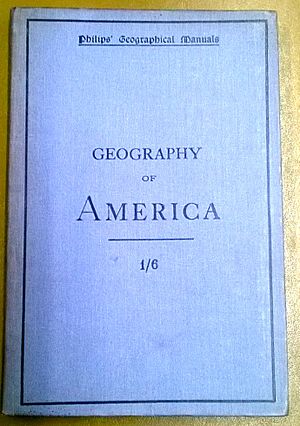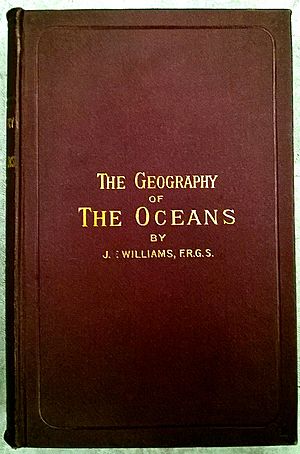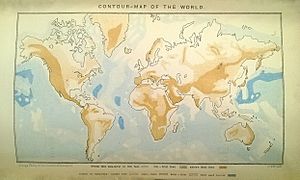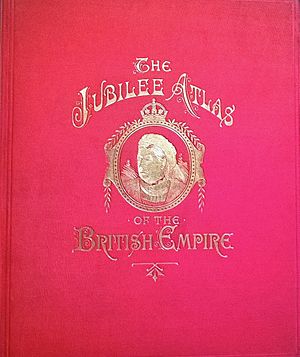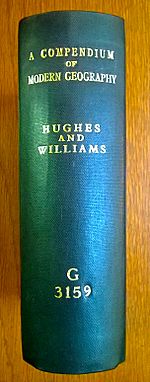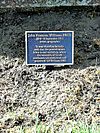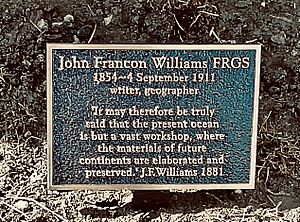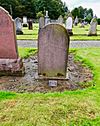John Francon Williams facts for kids
Quick facts for kids
John Francon Williams
|
|
|---|---|
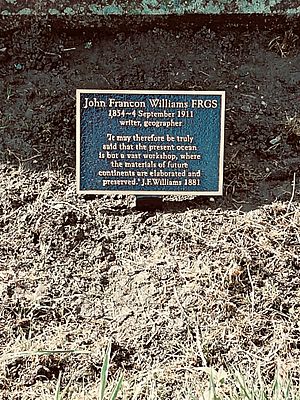
Williams commemorative plaque
|
|
| Born | 1854 Llanllechid, Caernarvonshire, Wales
|
| Died | 4 September 1911 Alloa, Clackmannanshire, Scotland
|
| Occupation | Writer, geographer, historian, cartographer, journalist and inventor |
| Spouse(s) | Barbara Balmain Dougall |
| Children | 5, including Aeneas Francon Williams and David Dougal Williams |
John Francon Williams (born in 1854 in Llanllechid, Wales, and died in 1911) was a talented Welsh writer, geographer, historian, journalist, and even an inventor! He was also a cartographer, which means he made maps. One of his most important books was The Geography of the Oceans.
Contents
- John Francon Williams: A Life of Learning and Maps
- Published Works
John Francon Williams: A Life of Learning and Maps
John Francon Williams was a very busy person who loved to learn and share knowledge. He wrote many books about geography and history, helping students all over the world understand our planet better. He was also a Fellow of the Royal Geographical Society, which is a group for people who study geography.
Growing Up in Wales
John was born in a small village called Llanllechid in Wales. His father, Richard, worked in a slate quarry, probably the Penrhyn Quarry. This quarry was owned by a rich family who also owned Penrhyn Castle. Richard later became an 'Overlooker,' which was like a supervisor at the quarry.
John grew up with two brothers and two sisters. They all went to the local school. John especially loved geography and history.
Moving to England and Starting a Family
When John was a young adult, he moved to Northampton in England and became a school teacher. There, he met Barbara Balmain Dougall, and they got married in 1876.
John and Barbara had five children: four sons named John Balmain, Aeneas Francon Williams, David Dougal Williams, and George Stanley, and one daughter named Margaret Mary Ann. The family moved around a lot, living in places like Northampton, Liverpool, and Liscard. John started working as a journalist and editor for a newspaper in Liverpool.
Sadly, in 1891, John lost his father, mother, and a brother. Later that year, his young daughter Margaret Mary Ann also passed away.
Barbara's Family from Scotland
Barbara Balmain Dougall was born in 1851 in Dunning, Scotland. Her father was a handloom weaver, and her mother wound cotton. Barbara was one of seven children.
Becoming a Famous Writer and Mapmaker
John Francon Williams became very well known for his work with George Philip & Son, a famous company that published maps and educational books.
Working with George Philip & Son
In 1881, John published his first book with them, called A Class-Book of Modern Geography. He worked with another map expert, Professor William Hughes. This book was very popular, and they published twelve different versions of it!
The company, George Philip & Son, was run by George Philip and later his son, George Philip II. They made many books and maps for schools around the world. George Philip II realized there was a need for good school textbooks, and John Francon Williams wrote and edited over forty books for them that were sold everywhere!
The Geography of the Oceans
One of John's most important books, The Geography of the Oceans, came out in 1881. This book was special because it was one of the first to focus so much on the geography of the oceans. It talked about how land and water are spread out, ocean currents, sea life, and the different oceans like the Atlantic and Pacific.
A reviewer from The Cornish Telegraph said it was "as fascinating as one of Jules Verne's novels!" The Daily Gazette called it "A new geographical work of great importance."
Map-Drawing Books and Atlases
In 1882, John created Philip's Series of Map-Drawing Books. These books helped students learn to draw maps step-by-step. Each book had a colored map, an uncolored map to fill in, an outline map, and even a blank sheet to draw on. Teachers loved them!
John was friends with other famous mapmakers like John Bartholomew the elder and William Hughes. He was also an inventor! He patented a special measuring rule and other items like pencils with movable leads.
In 1887, John helped create Philip's Handy Volume Atlas of the World. This small book had 110 maps and lots of facts. The Leeds Mercury said it was "quite a little geographical library in itself."
Working with George Newnes
In the late 1880s, John worked with George Newnes, a very important person in journalism. Newnes is known for starting popular magazines. This gave John ideas for his own magazine.
Reaching Out to Canada
John was always looking for new opportunities. In 1888, he sent a copy of his Atlas of British America to a politician in Canada, hoping it would be used in their schools.
Meeting Royalty
In 1889, John Francon Williams even met Albert Edward, Prince of Wales (who later became King Edward VII). John gave him a copy of his Philips' Handy-volume Atlas of the British Empire. This book is now kept in The Royal Collection Trust at Windsor Castle.
Teaching Geography to Young Children
John also wrote articles for a new magazine called Child Life in 1891. This magazine was for teachers who used Friedrich Fröbel's methods for kindergarten education. John wrote about how important maps are for learning geography. He said, "Maps are to geography what notation is to music." He also advised teachers to prepare their lessons carefully, especially for younger students.
More Books and Atlases
In 1891, Philip's published more of John's map-drawing books and a new set of Grammar School Atlases for different age groups. They also published Philips’ Picturesque History of England, which had many illustrations and maps. The Scotsman newspaper praised John for his lively writing and how well he showed important events and people.
In 1893, John helped create a huge 866-page book called A Compendium of Modern Geography. Even though William Hughes was listed as a co-author, John did most of the work because Hughes had passed away years earlier. This book was for advanced students and teachers, covering physical, political, and commercial geography of the world.
Starting His Own Magazine
In 1897, John started his own monthly magazine called Stories Illustrated. He sold it for a very low price to compete with other magazines. Later, George Newnes bought Stories Illustrated from John.
Later Years and Travel
In his later life, John Francon Williams became a representative for publishing houses. He traveled a lot, visiting cities like Edinburgh, Liverpool, and London, and even going to the United States and Canada to find new deals for publishers. His oldest son, John Jr., sometimes went with him.
John wanted to create an Anglo-American Syndicate to help promote publishers and their books around the world. He was especially keen to publish a worldwide Physical Atlas.
In 1899, he was asked to write a Gazetteer Pocket Atlas with thousands of places. He also wrote articles for Harmsworth Magazine, celebrating the amazing inventions of the 19th century.
John traveled to America several times for business. In 1901, his family moved to Chingford, England. Later, they moved to Clackmannan in Scotland to be closer to Barbara's sisters.
A Close Call: The Hawes Junction Rail Crash
On Christmas Eve in 1910, John Francon Williams and his son John Jr. were supposed to take an overnight express train from Manchester to Scotland to celebrate Christmas. However, because they were busy with work, they decided to postpone their trip.
This turned out to be a very lucky decision! The train they were supposed to be on crashed near Hawes Junction. The train hit another locomotive, and the wooden carriages caught fire. Many people were tragically killed. John and his son were safe because they changed their plans at the last minute. This was a true stroke of luck!
John's Final Years
By 1911, John was living in Leicester. He was still traveling a lot for his work as a publishers' agent.
Sadly, John Francon Williams passed away on September 4, 1911, from a brain hemorrhage. He is buried next to his wife, Barbara, in Clackmannan Cemetery in Scotland.
John's oldest son, John Balmain Williams, later joined the army during World War I and was killed in action in Belgium in 1918. He is remembered at the Scottish National War Memorial in Edinburgh Castle.
John Francon Williams was also the father of Aeneas Francon Williams, a missionary and writer, and David Dougal Williams, an artist.
Remembering John Francon Williams
On September 4, 2019, a special plaque was placed at John Francon Williams's grave in Clackmannan Cemetery. It honors him as a writer and geographer, and includes a quote from his book The Geography of the Oceans: "It may therefore be truly said that the present ocean is but a vast workshop, where the materials of future continents are elaborated and preserved."
John's Family in America and New Zealand
John's sister Grace and her husband Robert William Williams moved to the United States in 1892 with their two young children. They settled in Granville, New York. Robert worked as a slate quarryman, just like John's father. They had five more children in America.
One of Grace's sons, Robert Henry Williams, became a reporter and editor for newspapers. Another relative, also named John Francon Williams (after the famous author), became a well-known dentist in New Zealand. He even helped develop dental services in the South Pacific islands.
Published Works
John Francon Williams wrote and edited many books during his career. Here are some of them:
- A Class-Book of Modern Geography, (with William Hughes) – published by George Philip & Son, 1881.
- The Geography of the Oceans – published by George Philip & Son, 1881.
- Philip’s Series of Map-Drawing Books – published by George Philip & Son, 1882.
- Stories From English History – published by George Philip & Son, 1884.
- Philip's Handy-Volume Atlas of the British Empire – published by George Philip & Son, 1887.
- Philip's Handy Volume Atlas of the World – published by George Philip & Son, 1887.
- The Queen's Jubilee Atlas of the British Empire – published by George Philip & Son, 1887.
- A Compendium of Modern Geography (with William Hughes) – published by George Philip & Son, 1893.
- Philips’ Picturesque History of England – published by George Philip & Son, 1891.
- The Geography of the British Colonies and Dependencies – published by George Philip & Son, 1892.
- Everybody's Gazetteer and Atlas of the World – published by W. R. Russell & Co., 1900.
- The Story of Alfred the Great for Young Folks – published by George Philip & Son (Kindle edition 2012).


